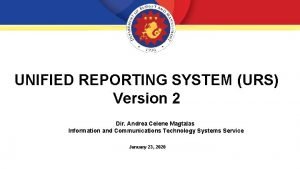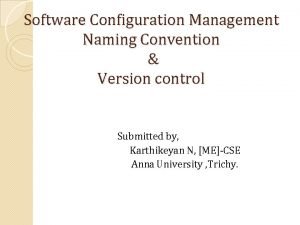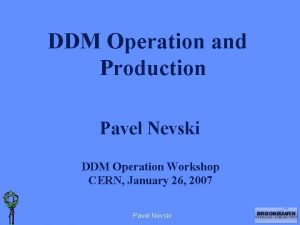VERSION 1 Definition Version is an operation in























- Slides: 23

VERSION 1

Definition Version is an operation in which the presentation of the fetus is artificially altered, either substituting one pole of the longitudinal fetus to the other, or converting an oblique or transverse lie into a longitudinal lie. 2

History Hippocrates Aeitus and Celsius Galen Ambroise Pare (1510 – 1590) Wigand (1807) Braxton Hicks 3

Types of Version External Cephalic version Internal Podalic version Bipolar version 4

External version Definition: External cephalic version is done to convert a transverse lie or oblique lie or a breech presentation into a cephalic presentation by abdominal manipulation. 5

Indications üBreech Presentation üTransverse or oblique lie 6

Contraindications Multiple pregnancy Ante partum hemorrhage Severe pregnancy induced hypertension Major degree of pelvic contraction Planned caesarean section Scar on the uterus of previous surgery Rh – isoimmunization Preterm labour in current pregnancy Patient is still preterm Elderly primigravida Threatened rupture of uterus Conditions that contraindicate tocolytic agents Gross fetal abnormality 7

Prerequisites for ECV ü Presenting part must not be engaged ü Abdominal wall must be sufficiently thin to allow palpation ü The abdominal and uterine wall must not be highly irritable ü The uterus must contain sufficient amount of liquor amnii to allow easy movement of the fetus ü Gestational age more than 32 weeks, referably 34 to 36 weeks 8

9

10

Postoperative Management Bed rest in left lateral position Tocolytic therapy for 2 hours Monitor fetal heart rate every 15 minutes for 2 hours Monitor maternal vital parameters every 15 minutes for 2 hours Watch for bleeding per vaginum, leaking and abdominal pain 11

Causes for Failure Complications 1. Too big baby 2. Too little amount of liquor 3. Frank breech 4. Obesity 5. Uterine leiomyomas 6. Uterine anomalies 7. Short umbilical cord • • Preterm labour Abruptio placenta Looping of cord Umbilical cord presentation Intra uterine death Premature rupture of membranes True knots in the cord 12

Internal Podalic Version Internal podalic version is the conversion of the fetal presentation from a transverse or cephalic presentation by both intrauterine manipulations as well as abdominal maneuvers 13

Indications • • • Second twin in transverse lie Failure of external cephalic version Transverse lie in multipara with full cervical dilatation Placenta praevia with excessive vaginal bleeding Fetus (dead or too preterm) to survive after a caesarean section 14

Contraindications A scar on the uterus from a previous operation Threatened rupture of the uterus Multiple pregnancy Congenital malformation of the uterus Major degree of pelvic contraction Placenta praevia degree III and IV 15

Prerequisites →Cervix must be at least ¾ dilated →Membranes intact or just ruptured →Uterus contracting intermittently with relaxation in between 16

Technique 1. Instrument trolley Iodine for part preparation Simple urinary catheter Sterile drapes: 4 Sponge holding forceps: 4 Version gloves: 2 pairs Episiotomy scissors Instrument for suturing an episiotomy 17

2. General anesthesia is given along with an uterine relaxant 3. Lithotomy position 4. Episiotomy is made 5. Glove application 6. Introduce the well lubricated right hand into the uterine cavity. 7. Rupture membranes if they are intact 8. Pass the hand on the dorsal aspect of the fetus to its ventral aspect along its breech. The superior leg is grasped and delivered across the ventral aspect of the foetus. 9. The leg is being brought down and the fetal head is manipulated abdominally and shifted to the uterine 18 fundus.

10. An immediate breech extraction may be planned. 11. Soon after the delivery, the uterine cavity is explored for injury 12. Halothane is discontinued. 13. Oxytocin infusion is started. 19

20

Complications Uterine rupture Postpartum hemorrhage Puerperal sepsis Foetal injury or death 21

Role of a nurse External cephalic version Check fetal heart rate before the procedure. Pre medications Fetal heart rate assessment soon after the procedure every 15 minutes for 2 hours. Observe for vaginal bleeding contractions and leaking. Internal podalic version Arrange for blood Preparation for general anesthesia Arrange operation theatre Resuscitation of newborn. 22

23
 Internal podalic version meaning
Internal podalic version meaning Operational definition of depression
Operational definition of depression Definition of binary operation
Definition of binary operation Tending operations
Tending operations Split brain operation subcortex definition psychology
Split brain operation subcortex definition psychology Leiyomayoma
Leiyomayoma Define unit operation
Define unit operation Numeracy progressions version 3
Numeracy progressions version 3 Vlan spanning
Vlan spanning Version control systems industry
Version control systems industry Urs v2
Urs v2 Uft version history
Uft version history Trigonometry sides maze
Trigonometry sides maze Hebrews 4 12 amplified version
Hebrews 4 12 amplified version The apostles creed prayer
The apostles creed prayer Svn version control tutorial
Svn version control tutorial Risk student version
Risk student version Configuration management version control
Configuration management version control Sac version 2
Sac version 2 Romeo and juliet prologue modern english
Romeo and juliet prologue modern english Alan rea
Alan rea A revised version of little red riding hood
A revised version of little red riding hood El principal autor de la biblia es
El principal autor de la biblia es Nhdplus version 2
Nhdplus version 2













































